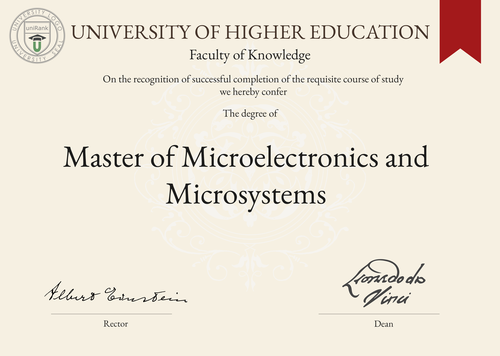
Master of Microelectronics and Microsystems (M.Micro)
Guide to University Programs/Courses
Master of Microelectronics and Microsystems (M.Micro)

Program/Course Name
Master of Microelectronics and MicrosystemsProgram/Course Abbreviation
M.MicroDuration Range
The duration of the program typically ranges from 1 to 2 years.Tuition range
The tuition fees for the program can vary depending on the chosen country or university. It is recommended to check with specific institutions for accurate information.Overview
The Master of Microelectronics and Microsystems program is designed to provide students with advanced knowledge and skills in the field of microelectronics and microsystems. It focuses on the design, development and application of integrated circuits, sensors and other microelectronic devices.Curriculum Overview by Year
The curriculum is structured to cover both theoretical and practical aspects of microelectronics and microsystems. The coursework includes subjects such as semiconductor devices, integrated circuit design, microfabrication techniques, sensor technology and system integration. Students also have the opportunity to engage in research projects and gain hands-on experience.Key Components
The key components of the program include in-depth understanding of microelectronics principles, hands-on experience with design and fabrication techniques, knowledge of sensor technology and the ability to integrate microsystems into larger systems.Career Prospects
Graduates of the program can pursue various career paths in industries such as semiconductor manufacturing, telecommunications, consumer electronics, medical devices and automotive electronics. They can work as microelectronics engineers, research scientists, design and development engineers, or project managers.Salary Expectations
The salary expectations for graduates of the Master of Microelectronics and Microsystems program can vary depending on factors such as location, industry and level of experience. Generally, professionals in this field can earn competitive salaries. For a more accurate understanding of salary expectations, you can utilize the Job Sites Search Engine, from our sister site jobRank, which searches over 4,600 job sites worldwide. Make sure to specify not only the job title but also the country you are interested in.Conclusions
It is important to note that the program duration, tuition fees, curriculum, key components, career prospects and salary expectations can vary based on the chosen country or location to study the program, as well as the chosen university. Prospective students are advised to research and compare different options to find the best fit for their academic and career goals.Furthermore, visitors interested in pursuing a Master of Microelectronics and Microsystems degree can utilize the uniRank World Universities Search Engine to explore universities offering this specific program worldwide. This search engine provides a comprehensive database of universities, allowing individuals to find relevant information and make informed decisions about their education.World Universities Search Engine
search for Master of Microelectronics and Microsystems (M.Micro) and add the Location (country, state etc.) or specific University you are interested in studying at.
Query examples:
- Master of Microelectronics and Microsystems (M.Micro) United States
- Master of Microelectronics and Microsystems (M.Micro) United Kingdom online
- Master of Microelectronics and Microsystems (M.Micro) Australia international students
- Master of Microelectronics and Microsystems (M.Micro) University of California
- Master of Microelectronics and Microsystems (M.Micro) University of London tuition fees
- Master of Microelectronics and Microsystems (M.Micro) University of Sydney scholarships